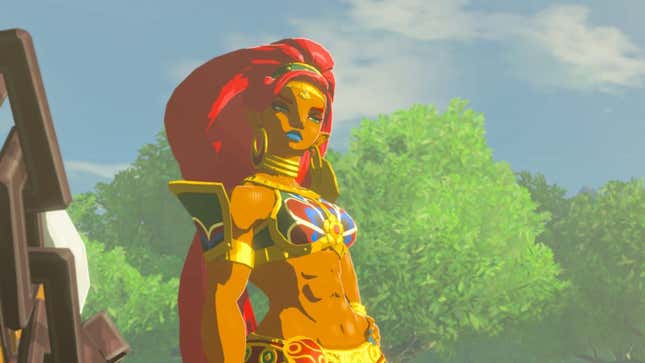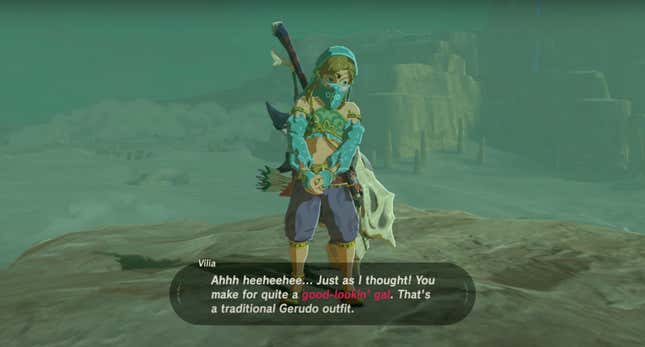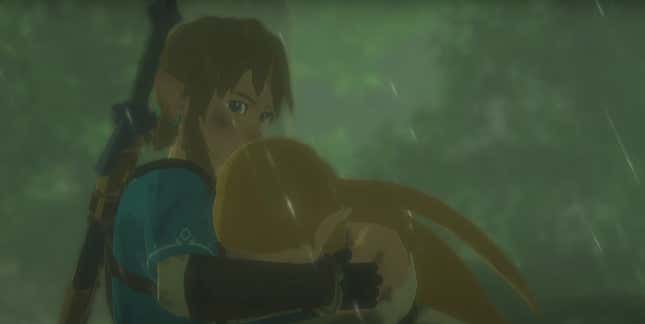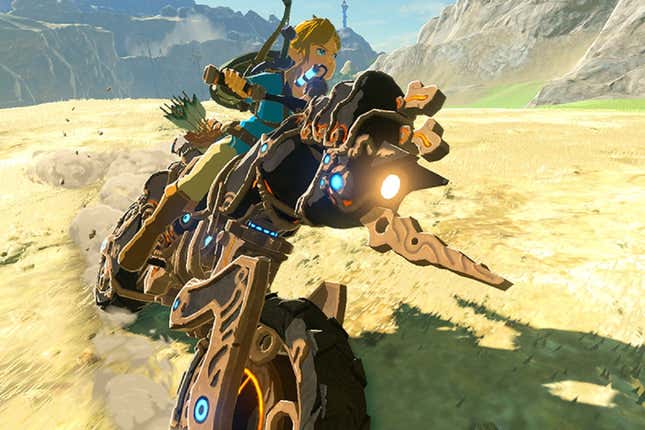

A Link Between Genders: Trans Joy and the Legend of Zelda
source link: https://gizmodo.com/legend-of-zelda-tears-of-the-kingdom-link-trans-1850430832
Go to the source link to view the article. You can view the picture content, updated content and better typesetting reading experience. If the link is broken, please click the button below to view the snapshot at that time.
A Link Between Genders: Trans Joy and the Legend of Zelda

“It is inevitable all of us will see something of ourselves within Link,” says Keroblin, a Zelda fan who first remembers playing Phantom Hourglass in 2007, and identifies as transmasculine and agender. “We’re an active participant even [when] we can’t make narrative decisions, because we get to decide who Link is. It is easy to discover yourself and your gender through a character like this, and to make trans readings, as the lack of traditional gender roles creates, maybe for the first time you’ve seen, a world where all you have to be is kind and brave.”
Today, Nintendo released Legend of Zelda: Tears of the Kingdom; the sequel to 2017’s Breath of the Wild. Both games (and really, all the games in the Zelda franchise) follow a young man named Link who is tasked with rescuing the kingdom of Hyrule from a great evil. Breath of the Wild was an incredibly beautiful, poignant game, full of emotional stories and sidequests; it ushered in an era of exciting new open-world gameplay for the Zelda franchise. Breath of the Wild quickly became a bestseller and later won Game of the Year at the Game Awards. And now, gamers are returning to its version of Hyrule. But some of them have changed.
Lutavia, a cosplayer, says that they cosplayed as Link after Breath of the Wild came out, but at the time they still believed that they were cisgender. Now? “I am a vastly different person,” they said in an email to io9. They currently identify as transmasc and genderfluid, an identity that falls under the nonbinary gender umbrella. With the new game coming out, “it felt like a good time to finally re-approach him, and with a design that begged to be interpreted in a more [transgender] way.”
Link has been described by many trans people as an “egg-cracker”—someone (or something) who makes people realize they’re transgender. It’s moment of awakening when little pieces of a person’s experience fit into place and trans people begin to understand their life and gender through a new paradigm. For many gamers, Link’s appearance, mannerisms, and even his embodiment of positive masculine traits all create a space where people can inhabit those parts of the character, creating moments of realization in their own lives outside of Hyrule.
When I reached out to trans gamers to ask them about their relationships with Zelda and Link, the response was immediate and overwhelming—what you’ll find throughout this piece are highlights emphasizing the trans lens people see the series and its protagonist through, rather than the totality of what people told me. But even then, it is clear that Link means a lot to the transgender gamer community, and the joy he brings to many people is deeply affecting and wonderfully tangible. Many people have asked to be identified by either their first names or pseudonyms, due to transphobia in the gaming community and the world at large.
One of the things that many transgender people I spoke to mentioned about Link that drew them towards a trans interpretation is the fact that Link seems designed to support that reading. Eiji Aonuma, a longtime Zelda producer since Ocarina of Time, said in an interview with Time magazine in 2016 that a few games ago, he took this approach to Link’s design:
I wanted Link to be gender neutral. I wanted the player to think ‘Maybe Link is a boy or a girl.’ If you saw Link as a guy, he’d have more of a feminine touch. Or vice versa, if you related to Link as a girl, it was with more of a masculine aspect. I really wanted the [design] to encompass more of a gender neutral figure. So I’ve always thought that for either female or male players, I wanted them to be able to relate to Link… As far as gender goes, Link [in Breath of the Wild] is definitely a male, but I wanted to create a character where anybody would be able to relate to the character.
By many accounts, Aonuma was successful. Because of the way that the 2017 game encourages players to set their own pace and go towards whatever part of the map interests them, and are rarely “locked in” to a certain dungeon or story path, “Breath of the Wild is about freedom and exploration,” says Matt, a nonbinary fan who first played The Legend of Zelda on NES in the ‘90s when his brother wasn’t at home. He says that these themes “carried over, consciously or subconsciously,” to the character design. “Male, female, masculine, feminine—lack thereof or in between, it’s all about exploration.”
“It’s just really easy to [see Link as trans],” says a cosplayer who has recently named themselves Link. “It’s fun to imagine yourself in a world like that, expressing yourself without consequences. The fact that we live in an age where such private exploration is possible? I consider myself pretty lucky.”
Eclipse, who first played a Zelda game in 2007 (the handheld release Phantom Hourglass) writes in an email that they can easily see Link as embodying any number of trans identifiers, explaining that Link can be any gender under a certain lens. “As a trans man, Link is soft-faced and hard-bodied yet slim, elements I think a certain subset of trans men can identify with. As a trans woman, Link is seen as a man but is soft-faced, and often bucks male gender norms or wears women’s clothes.” They also state that “he’s a character who simply emanates t-boy swag. The way Link dresses, carries, and presents himself across the entire series SCREAMS transmasc to me.”
“Legend of Zelda, as a series, makes a POINT of designing masculine and feminine characters in slightly (or not so slightly) exaggerated ways to let you know that they’re male/female,” explains Vic, a fan who began playing Zelda games on the N64. “Look at Ganon for example, or Groose, or women like Urbosa. They are clearly coded, physically and behaviorally, as men or women. But not Link. Link experiences and views the world in an almost genderless way.”

Link, as designed in Breath of the Wild and many other iterations across the Zelda franchise, is relatively small and slim. He’s shorter than many other characters in the story, and rarely presents as a dominating presence. Even Zelda—his female counterpart in the games—more often than not stands at about the same height as he does. While he often has an athletic build, he is not bulky or overly muscular. And in Breath of the Wild specifically, as Finn, a trans man, points out, “Link has hips. Visible hips,” rather than a more stereotypical large body type typically seen on default male video game personas. He continues, explaining that “seeing a dude with hips helps my dysphoria.”
Immersion, and by extension projection, has always been a huge part of video games in the role-playing tradition, and many trans people feel comfortable playing Link because of the in-between-ness of his design. One of the side quests in Breath of the Wild asks Link to sneak into Gerudo Town, a desert city that is made up entirely of women. In order to do so, Link purchases a set of female Gerudo clothing from another Hylian—who many read as a trans woman—and proceeds to walk right into Gerudo Town. This quest has had mixed reactions, but for many trans people, the simple act of putting on and taking off clothes to indicate a change of gender—rather than having to perform or mask any other parts of his body—in order to pass as suitably feminine or masculine was a very liberating moment.
Vaya, a trans fan who first played as Link in Link’s Awakening back in 2000 and now considers this fact “hilariously appropriate,” says that “it can be really confusing navigating that self-discovery process and adjusting presentation.” Legend of Zelda actively helped during their gender journey. “Having Link to look toward [as a role model] re-contextualized so many features and qualities that I had been socialized to view as feminine. But if the Hero of Time could put on ‘girl’s clothes,’ be perceived as a woman, then take off those clothes and be assured in his identity, so could I.”
Another fan, Jay, explains that the Gerudo side quest was a “moment where Link is able to pass between the perceived rigidity of masculine and feminine spaces that really got to me and made me feel (what I did not understand at the time as) gender euphoria.” This moment of passing was “fundamentally different from any other game at the time for me because it was not just choosing to play as male or female, but rather shifting to the other side of the binary for a short time.” Another aspect many fans mentioned was that this side quest didn’t show Link as being ashamed or uncomfortable in women’s clothing. When he’s complimented on how cute he looks, he blushes and accepts the compliment. It’s an understated, yet deeply affirming interaction, but often these small moments of confidence are what stick with people the most.

The story and character development throughout the series also provide moments of projection for trans people. Link is one of the few characters in the Zelda franchise that rarely, if ever, gets a voice actor, outside of grunts and yells in combat. All of Link’s dialogue within narrative conversations is implied, which especially stands out in cutscenes where other characters are fully voiced as they were in Breath of the Wild. Ritz, another trans fan of the series, says that they interpret this as Link “masking” his voice, which many trans people do when they want to emphasize or downplay gender markers.
Link also embodies traditionally masculine heroic traits in a positive and generally unharmful way. The Zelda franchise is aimed at young adults and children, and it is not considered particularly graphically violent—that means no blood, no bodies, no explicit gore. When enemies die, they disappear in puffs of smoke, leaving loot behind. Most of the enemies Link faces are monsters or machines (and occasionally “corrupted” characters), and while death is a frequent theme throughout all the Zelda games, it exists in the story, not usually in the actual play of the game beyond the conflict of combat. Additionally, although Link and Zelda are occasionally shown to be friends, and sometimes implied to be in love, he never rescues her with the hope of winning her, or becoming her romantic partner—sexual attraction is not the endgame of their relationship. Without a lot of ties to that historical gender-coded violence and without a lot of gender-specific dialogue, many trans people have recognized the power of being perceived as male through Link’s gameplay.
“To me, Link was a positive gender influence [even] before I saw myself as nonbinary,” explains Teo, who loves Breath of the Wild. “Even when I thought I was a cis man, Link was a more alluring image of masculinity than other [characters] in the gaming space and media in general.”
Leon, a transmasc nonbinary person who first played Link in the GameCube title Wind Waker, says that “in modern iterations of Link, I identify with his courage and his desire to protect his friends. Link [in Breath of the Wild] is empathetic and sensitive, but also he’s reckless... as a transmasc person, with quite a few transmasc friends, I feel like there are a ton of us who fit that bill: reckless, non-toxic masculinity.”
Cailín, an agender, nonbinary trans woman, tells me that Link reminds her of one of her trans masculine friends. “Because of that, and because of Link’s personality, I’ve become so attached [to the character]. That mixture of totally goofy and sweet, and that really fierce, protective bravery is something I find really special and unique to transmasculinity, and as someone who can feel very scared around cis men and thought I was scared of masculinity in general… after I was around trans men I realized how wonderful and powerful [masculinity] is, and how much it makes me feel safe to be myself.”

“To me, Link represents a kind of masculinity that I aim to embody: protective but not possessive, strong but not violent, excitable and kind and adventurous,” says another nonbinary fan who alsotook Link as their chosen name; the character meant that much to them. “I think there’s a lot of pressure on trans men and transmasculine folks to be ‘traditionally masculine’ in order to pass, but many of those features can have a crossover with toxic masculinity. But if the main character of one of the most popular video games of all time can be a softer kind of man, then I can too.”
Mischa, who identifies as demi-fae and nonbinary, says that “I relate to Link’s gender because I too am just out here living my life, fulfilling my quests, trying to find enough rupees to get by... and then, somewhere out there, an overwhelmingly large group of people I don’t have anything to do with has large, loud opinions about [my life] on the internet. And I just try to ignore it and smash some pots.”
There are so many issues, politically, socially, and legally, that surround transgender people, often taking over their lives and the discussions about trans people in the larger cultural space. For many gamers who find solace in video games, or even just casually enjoy video games, being able to play as Link—a character that for all intents and purposes could be a trans man, trans woman, or any other gender—who is always, constantly, across all timelines, the courageous hero of Hyrule, feels like a kind of liberation. Link is the hero of Breath of the Wild; he’s been the hero of the franchise for decades, forever, since time immemorial.
There’s a massive quest in Breath of the Wild where Link is supposed to find all of his memories after suffering from amnesia. This is partially a tactic to encourage exploration, as memories—via cutscenes—are unlocked at various locations, but it also reads as a trans allegory. “You can choose not to remember. You can choose not to chase after who Link was before. Link has this clean slate—haven’t we all wanted a clean slate?” Markus, a fan who first played as Link in Twilight Princess, asks. “Where nobody remembers who you were pre-transition, where you can choose to forget any of the skin-crawling moments from puberty. You can just choose not to. The majority of people from a century ago are dead; everyone else believes the Legendary Swordsman is a myth, or else dead. Link is the name of a dead man. That’s quite literally a Dead Name of a knight who swore loyalty, who upheld a duty. Link now can choose to put down the oaths he swore a literal lifetime ago. You as a player have all the time you want, all the time you need, to explore to your heart’s content before you make your way to Hyrule Castle. You’re not beholden to the past, to people who expect you to be any specific way you once were, any more than you chose to be.”
“If everyone who has ever held a controller to play a Legend of Zelda game is meant to be Link, then how else [am I supposed to] interpret the character?... Link can do anything. So can I,” says Morgan, a nonbinary person who first played as Link in Skyward Sword when they were a teenager. “People believe in Link; so that means there have to be people who believe in me.”
It’s not just that Link can do anything, it’s that gender euphoria is a strange, multifaceted thing. There are so many ways to experience gender, so many different aspects of a trans person’s life that can bring joy, that can bring euphoria—even as the world tells many trans people they should feel dysphoric, they should hate their bodies, they should hate themselves. Link allows trans people to feel joy. Link gives trans people gender euphoria, regardless of if they perceive Link’s gender as similar or different from their own.
When asked how playing as Link makes them feel, a trans nonbinary fan who wants to be called Stenoscope because “the world exists” says, “Like I can do whatever I want forever. Even if when I turn off the game I’m back in the ‘real world,’ while I’m interacting with Link in all Link’s transness I feel like I maybe make more room for my own transness. I have this sort of unshakeable... faith? Belief? In Link being trans, and being able to have that belief about, you know, pixels, has been really eye-opening about how many hoops I make myself jump through before I feel ‘trans enough.’ Also it makes me want to SURF on a SHIELD.”
“Putting Link in the Ancient Armor and riding the motorcycle with a huge Lynel spear, spinning it around while I taunted Guardians was maybe the most gender shit in my life.” Eclipse explains. “Gender can be anything.”

Vaya says that they played around with a lot of Link-inspired hairstyles and outfits as they began their journey of gender discovery, and says that “those were some of the brightest moments for me, just feeling like I DID look masculine, and I DID look strong and capable. It was the kind of joy that had me running out into the yard to listen to music and laugh, you know?”
Link adds that “it feels good to imagine a Chosen One as being like me! Link’s journey as THE hero is such a burden and yet he approaches every new person with openness and curiosity, getting excited over new recipes and new powers…I also love the escapism that can come from just being happy-go-lucky. When the world gets me down, I can think of the cheerful hero and just ask myself ‘What would Link from Breath of the Wild do?’ and that can become ‘What is Link (As In Me) going to do?’”
“Headcanoning Link as nonbinary makes me feel hope and makes me feel like my experience and life have meaning… Their role as HERO also empowers them—they are Hyrule’s last hope. Not only that, their specific experiences make them the ideal hero for the ages, time and time again. None of that relies on gender or sex. It relies on THEM,” Vic explains. “That is EXTREMELY powerful to me and brings me immense joy and hope, because in OUR world, trans and nonbinary people ARE the future. They bring beauty and perspective and wonder and joy that is both unique to their experience and also tied inextricably to the overarching human experience. It makes me hope that one day, people in our world can see us the way Zelda and Hyrule see Link—as a priceless and integral part of human life.”
Legend of Zelda: Tears of the Kingdom is available now.
Want more io9 news? Check out when to expect the latest Marvel, Star Wars, and Star Trek releases, what’s next for the DC Universe on film and TV, and everything you need to know about the future of Doctor Who.
Recommend
About Joyk
Aggregate valuable and interesting links.
Joyk means Joy of geeK